Deauville, lady of the French coast, its most glamorous seaside resort, symbolizes elegance, prestige and sophistication. The city of the race horse, the gateway to Calvados, the playground of the rich.
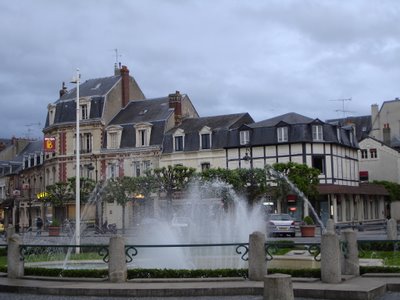
Deauville started off as a small farming village on Mont-Canisy, a hill rising above the sea. The hundred or so inhabitants of Dosville whose houses were clustered around the church of Saint-Laurent, lived mainly from agriculture and livestock farming. The marshes and the dunes, down from the village, where the future Deauville was to be built, were pastureland where cattle and sheep grazed.
It was during the summer of 1858 that the Duke of Morny, Napoleon III's half-brother, who had been invited to Trouville by his physician, Doctor Olliffe, became inspired by the idea of building a kingdom of elegance close to Paris on this stretch of sand and marsh : the seaside resort of Deauville.
Morny, in partnership with Doctor Olliffe, the banker Donon and the architect Breney, created a town in four years, whose casino, Grand Hotel, beach and racecourse were soon to attract a clientele from the Parisian and international aristocracies...
Over a period of three centuries, Deauville has remained up to date, developing from seaside resort, active for a few weeks in the year, to embrace the culture of the all year round week-end retreat, without for all that renouncing its cultural and architectural roots. It is beautiful, and one does not wonder why the rich and the famous come to play and relax in Deauville. The half-timbered gingerbread house style of the buildings, the masses of flowers everywhere, the flying flags from every nation, the beach huts, and fountains, wide white beaches and colourful sun umbrellas, the swish little boutiques and the imposing casino -- all make it look like a giant Hans Christian Anderson film set.
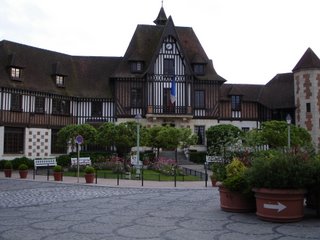 One of the most impressive buildings is the Normandy Barrière Hotel. Built in 1912 on the instigation of Eugène Cornuché, a businessman and the creator of Maxim's in Paris, Désiré Le Hoc, the Mayor of Deauville, and the architect Théo Petit, the Normandy Hotel, with the casino, replaced and updated the Second Empire style of construction. The new luxury hotel was immediately successful thanks to its level of comfort, facilities, furnishings and novel interior decoration. The exterior façades are finished with imitation wood panelling in celadon, the pale green used in Chinese porcelain.
One of the most impressive buildings is the Normandy Barrière Hotel. Built in 1912 on the instigation of Eugène Cornuché, a businessman and the creator of Maxim's in Paris, Désiré Le Hoc, the Mayor of Deauville, and the architect Théo Petit, the Normandy Hotel, with the casino, replaced and updated the Second Empire style of construction. The new luxury hotel was immediately successful thanks to its level of comfort, facilities, furnishings and novel interior decoration. The exterior façades are finished with imitation wood panelling in celadon, the pale green used in Chinese porcelain.Another wonderful characteristic that gives Deauville such a picturesque image, are the decorative finials on the roofs of the beautiful buildings. An oriental tradition since the 12th Century, decorative finials in varnished terracotta have been a typically Augeron speciality since the 15th Century. These terracotta ornaments have diversified and now confer a veritable identity on the manor houses whose roofs they grace. There are three main categories of motif : flora, fauna, and the allegorical.
And of course, if you go to Deauville, there are three things you have to do:
Either spend some time on your yacht in the harbour to make sure it has been efficiently 'de-wintered', or have a quick game of bridge with the world champion, Omar Shariff; go to the the Deauville-La Touques racecourse and see which horses the Aga Khan is racing this season and catch up on the latest wine gossip with the Rothschilds and have a chat with your trainer and jockey while you are there; and of course, visit the Casino!
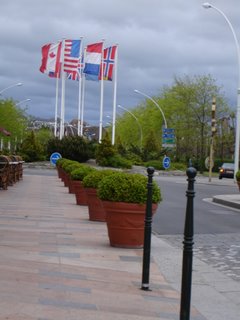 The Casino first opened its doors in 1864, but was demolished thirty years later in 1895. It was replaced in 1912 by an edifice designed by the architect Georges Wybo, which took its inspiration from buildings dating from the 18th Century, evocative of festivals and the simple pleasures of rustic frivolity, like the Petit Trianon, the opera house of the Château de Versailles, and the small theatres on the Champs Elysées built during the Restoration period. Its neo-Louis XVI architecture has been modified over time to suit the tastes and fashions of its aficionados; the façade has been moved forward by 6 metres, enabling a large gallery to be created, and it is now open on the seaward side. It is ranked among the major casinos in Europe and is the third largest in France.
The Casino first opened its doors in 1864, but was demolished thirty years later in 1895. It was replaced in 1912 by an edifice designed by the architect Georges Wybo, which took its inspiration from buildings dating from the 18th Century, evocative of festivals and the simple pleasures of rustic frivolity, like the Petit Trianon, the opera house of the Château de Versailles, and the small theatres on the Champs Elysées built during the Restoration period. Its neo-Louis XVI architecture has been modified over time to suit the tastes and fashions of its aficionados; the façade has been moved forward by 6 metres, enabling a large gallery to be created, and it is now open on the seaward side. It is ranked among the major casinos in Europe and is the third largest in France.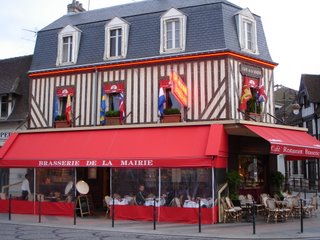
A visit well worth your while is the C.I.D or Centre International de Deauville. Inaugurated in 1992, it was built 14 metres below sea-level in order to preserve the view over the ocean. A veritable technical feat, both with regard to its architecture, the idea of a Deauville architect facilities and fittings, it has opened Deauville to business tourism and an international clientele. Or, if something more old-fashioned grabs your fancy, visit the Pompeian Baths. In 1921, the Deauville town council organised a competition for the renovation of the wooden bathing cabins. The prize-winner, Charles Adda, built the Pompeian Baths in 1923, whose atrium enfilade, arcades and mosaics refer back to the archaeological models of Antiquity. At that time, the establishment consisted of 250 cabins, a bar, shops and Turkish baths. The Pompeian baths are registered on the additional list of historic seaside monuments.
 My favourite place though will always be Les Planches -- or the boardwalk. This famous promenade along the beach, made in 1923 of ekki or eba, a species of hardwood from Madagascar that is reputed to be totally resistant to decay and rot, is 643 metres long. It is lined on one side by small cabins sporting the names of the American stars who have come to Deauville during the American Film Festival, and on the other by the celebrated coloured parasols, whose dominant blue and red are the colours of Deauville.
My favourite place though will always be Les Planches -- or the boardwalk. This famous promenade along the beach, made in 1923 of ekki or eba, a species of hardwood from Madagascar that is reputed to be totally resistant to decay and rot, is 643 metres long. It is lined on one side by small cabins sporting the names of the American stars who have come to Deauville during the American Film Festival, and on the other by the celebrated coloured parasols, whose dominant blue and red are the colours of Deauville.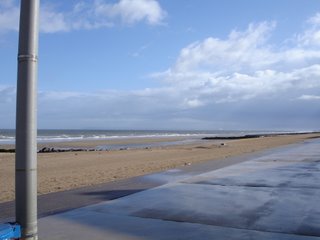 There is much else to see and do besides. To name but a few more: Le Circle, where the race-horse owners from major stables have been meeting since 1875, the Elie de Brignac Establishment, one of the world's leading thoroughbred horse markets, or the Villa Strassburger, which is on the site of a farm belonging to Gustave Flaubert's family: Henri de Rothschild had a villa built by an architect from Caen, Pichereau, which came to be called the Ferme du Coteau (the hillside farm). Following the Great War, the villa was bought by the wealthy American Beaver Strassburger, it became his favourite residence. His son donated it to the Town of Deauville in 1980. Its design is a combination of both the rural architectural style and that of Pays d'Auge manor house. The luxury of its fittings and furnishings and its picturesque style make it one of Deauville's most beautiful villas. It has been listed on the additional Historic Monuments register since 1975.
There is much else to see and do besides. To name but a few more: Le Circle, where the race-horse owners from major stables have been meeting since 1875, the Elie de Brignac Establishment, one of the world's leading thoroughbred horse markets, or the Villa Strassburger, which is on the site of a farm belonging to Gustave Flaubert's family: Henri de Rothschild had a villa built by an architect from Caen, Pichereau, which came to be called the Ferme du Coteau (the hillside farm). Following the Great War, the villa was bought by the wealthy American Beaver Strassburger, it became his favourite residence. His son donated it to the Town of Deauville in 1980. Its design is a combination of both the rural architectural style and that of Pays d'Auge manor house. The luxury of its fittings and furnishings and its picturesque style make it one of Deauville's most beautiful villas. It has been listed on the additional Historic Monuments register since 1975. 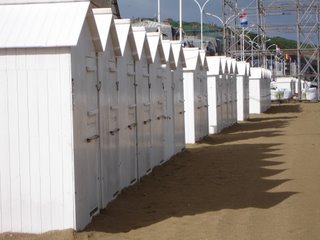
"The two great Cowes that in loud thunder roar, This on the eastern, that the western shore".
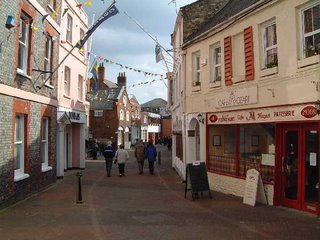
Cowes, on the other hand, did not tempt me away from my books and my studies, and the one ray of bright sunshine during an otherwise grey and wet and cold sojourn, was our VHF radio instructor, Angus!
 Cowes is a seaport town on the Isle of Wight, an island due south of the major southern English port of Southampton. It is located on the west bank of the estuary of the River Medina and the only thing that can really be said in its favour, is that it hosts the world's oldest regular regatta, Cowes Week, which occurs in the first week of August, and is home to the world famous Royal Yacht Squadron, which ranks amongst the world's elite yacht clubs.
Cowes is a seaport town on the Isle of Wight, an island due south of the major southern English port of Southampton. It is located on the west bank of the estuary of the River Medina and the only thing that can really be said in its favour, is that it hosts the world's oldest regular regatta, Cowes Week, which occurs in the first week of August, and is home to the world famous Royal Yacht Squadron, which ranks amongst the world's elite yacht clubs. East Cowes is home to Norris Castle, and Osborne House, the former summer residence of Queen Victoria and Prince Albert. The Prince had a major influence on the building of St Mildred's Church in Whippingham, East Cowes, which features distinctive turrets imitating those found on a German castle. -- and do not forget:
Visitors arriving at East Cowes find it hard not to notice the worlds largest Union Jack on the hangar doors of the building originally used by Saunders Roe and successive marine and aerospace manufacturing companies.
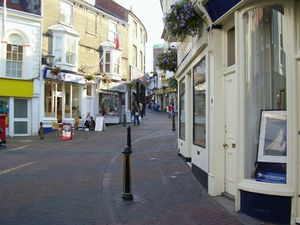
The story goes that Cowes and East Cowes derive their names from the time of Henry VIII, when fortifications called cowforts or cowes were built on the east and west banks to dispel a French invasion; or else it is possible that Cowes and West Cowes were named after two sandbanks, one on each side of the River Medina estuary, and recorded in 1413 as Estcowe and Westcowe, which were named after a supposed likeness to cows (animals).
It was not until the reign of keen sailor George IV that the stage was set for the heyday of Cowes as 'The Yachting Capital of the World.' In 1826 the Royal Yacht Squadron organised a three-day regatta for the first time and the next year the king signified his approval of the event by presenting a cup to mark the occasion. This became known as Cowes Regatta and it soon grew into a four-day event that always ended with a fireworks display.
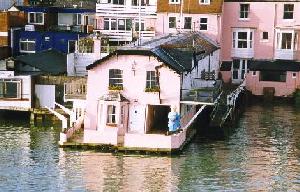
Local industry in both Cowes and East Cowes has always centred on the building and design of marine craft, including the early flying boats, and sailmaking. It is also noted as the place where the first hovercraft was tested. East Cowes was also once home to the manufacturer Saunders Roe, who built the flying boat The Saunders-Roe Princess.
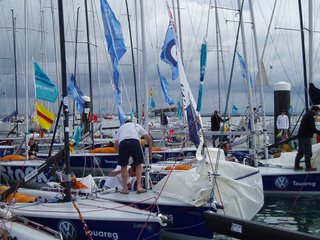
Click on Link:
Chateau Lalinde : The perfect venue for your event
TAGS: Events Rent a chateau France
Chateau
Perigord Food Holidays in France Recipes







